(Optimizado para dispositivos de pantalla pequeña)
Village house (community centre) - Kakasd, Hungría
Cuando se hace clic:
¡Haga clic en las imágenes!
-
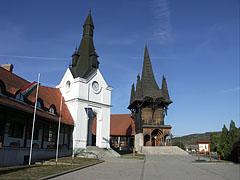
Village Community Center ("Faluház"), the two different style building sections and towers, Swabian and Székely one
Designed by Imre Makovecz in 1986
Fecha de la fotografía: 01/10/20092009
Creado por: Robert Németh
Modelo de la cámara: Konica Minolta Dimage A200
Kakasd, Hungría
-
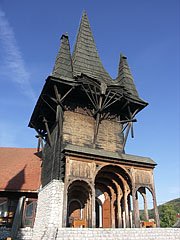
The "Székely Tower" of the Village Community Center of Kakasd
Work of Székely carpenters, it was completed in 1991.
Fecha de la fotografía: 01/10/20092009
Creado por: Robert Németh
Modelo de la cámara: Konica Minolta Dimage A200
Kakasd, Hungría
-
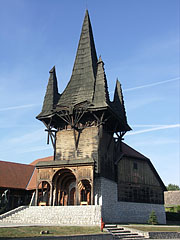
Village Community Centre (in Hungarian "Faluház"), the "Székely Tower"
Fecha de la fotografía: 01/10/20092009
Creado por: Robert Németh
Modelo de la cámara: Konica Minolta Dimage A200
Kakasd, Hungría
-
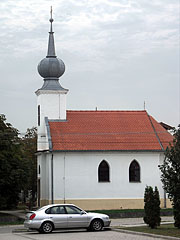
St. Anne's Chapel (or Szent Anna Chapel)
Fecha de la fotografía: 01/10/20092009
Creado por: Robert Németh
Modelo de la cámara: Konica Minolta Dimage A200
Kakasd, Hungría
-

The grand hall of the Village Community Center ("Faluház"), and special Szekely patterns on its ceiling
Fecha de la fotografía: 01/10/20092009
Creado por: Robert Németh
Modelo de la cámara: Konica Minolta Dimage A200
Kakasd, Hungría
-
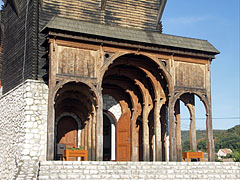
The special "Székely gate" of the Village Community Center in Kakasd
Fecha de la fotografía: 01/10/20092009
Creado por: Robert Németh
Modelo de la cámara: Konica Minolta Dimage A200
Kakasd, Hungría
-
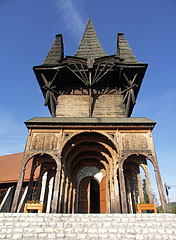
Village Community Center, the wooden "Székely Tower" with the five "Székely gates" in unique arrangement
Fecha de la fotografía: 01/10/20092009
Creado por: Robert Németh
Modelo de la cámara: Konica Minolta Dimage A200
Kakasd, Hungría
-

The five Székely gate of the Village Community Center symbolize the five old settlement of the Székelys of Bukovina (they found the shelter here)
Fecha de la fotografía: 01/10/20092009
Creado por: Robert Németh
Modelo de la cámara: Konica Minolta Dimage A200
Kakasd, Hungría
-

The Swabian and the Székely towers of the Village Community Center represents the common destiny of these two nations
Fecha de la fotografía: 01/10/20092009
Creado por: Robert Németh
Modelo de la cámara: Konica Minolta Dimage A200
Kakasd, Hungría
-

Community Center of Kakasd, the entrance and a small lobby in the Székely Tower
Fecha de la fotografía: 01/10/20092009
Creado por: Robert Németh
Modelo de la cámara: Konica Minolta Dimage A200
Kakasd, Hungría
-
Picture in the Village Community Centre: "Traditions of Kakasd"
Painted by Sándor Bíró
Fecha de la fotografía: 01/10/20092009
Creado por: Robert Németh
Modelo de la cámara: Konica Minolta Dimage A200
Kakasd, Hungría
Picture in the Village Community Centre: "Traditions of Kakasd" - Kakasd, Hungría -
Hand-painted panels (or coffers) on the ceiling
Designed by Ildikó Ferentz
Fecha de la fotografía: 01/10/20092009
Creado por: Robert Németh
Modelo de la cámara: Konica Minolta Dimage A200
Kakasd, Hungría
Hand-painted panels (or coffers) on the ceiling - Kakasd, Hungría
¡Haga clic en las imágenes!
Características, propiedades
Posición:
Coordenadas GPS: Actualmente no está disponible
Información, historias cortas, datos interesantes
 The "Székely Tower" of the Village Community Center of Kakasd
The "Székely Tower" of the Village Community Center of Kakasd
Work of Székely carpenters, it was completed in 1991.
The Székelys of Bukovina are a Hungarian ethnic group with troubled, chequered history, initially they lived in Székely Land or Szeklerland, Transylvania (in Hungarian "Székelyföld, Erdély", which is today in Romania). The decree of the Austrian Empress Maria Theresa concerning the border guard duties and issued in 1763 led to forced recruitments in Transylvania, because the Szekelys didn't want to give up their right to self-determination. Finally in 1764 it escalated into the so-called Massacre at Madéfalva, in Latin also known as the Siculicidium which means the mass murder of the Székely people (by the way, the Romanian name of the Szekely-Hungarian Madéfalva settlement is Siculeni, which is also derived from the Latin name of the Szekely people: "siculus"). The Habsburg imperial army massacred about 400 people by cannon fire, including innocent women and children.
In relation to this event also there is an interesting and little bit mysterious curiosity. If we take all the letters of the Siculicidium ("SICVLICIDIVM") word and add them as Roman numerals the result will be 1764, which is exactly the year of the massacre (the letter "S" cannot be converted to a Roman numeral, sot its value is 0 in this case). This is a so-called chronogram, a kind of playing with the letters, that was first used at the time of the ancient Roman Empire, but it became very popular just in the Renaissance and Baroque eras. This mysterious chronogram also can be found on the monument in the former Csík-Madéfalva (present-day Madéfalva or in Romanian Siculeni) village. The memorial sculpture was erected in 1899 and represents a stone obelisk with a turul bird on its top.
 The five Székely gate of the Village Community Center symbolize the five old settlement of the Székelys of Bukovina (they found the shelter here)
The five Székely gate of the Village Community Center symbolize the five old settlement of the Székelys of Bukovina (they found the shelter here)
The mass murder of 1764 in Madéfalva and the further forced recruitments led to the exodus of thousands of Szekely people to the Moldva historical region that is situated north-east of Transylvania. They found refuge for a time here in the villages of the Csangos, who are another Hungarian ethnic group and living there since centuries ago.
In 1774 the formerly Ottoman-ruled region came under the suzerainty of the Austrians, an thanks to the intercession of Count András Hadik the Szekely people got amnesty from them. So some of them could resettle to the depopulated Bukovina region (the historical region was somewhere between the present-day Romania and Ukrain). The Szekelys of Bukovina founded five villages in the area between 1764-1786: Hadikfalva, Istensegíts, Fogadjisten, Józseffalva és Andrásfalva (in Romanian Dornești, Țibeni, Iacobești, Tolova and Măneuți respectively).
 The Swabian and the Székely towers of the Village Community Center represents the common destiny of these two nations
The Swabian and the Székely towers of the Village Community Center represents the common destiny of these two nations
Some of the Székelys of Bukovina (about 6500-7000 people) migrated further from Moldva and Bukovina regions between 1883-1910. About 4000 people settled to the surroundings of the Lower Danube (in Hungarian "Al-Duna", in present-day Serbia), and the other ones dispersedly in several villages in the Transylvania region (in Hungarian "Erdély", today in Romania). In addition, many of them migrated to Canada between 1905-1914, as well as others to Brazil in 1924, and they established their own farms in the overseas.
But the sufferings of the Bukovina Szekelys who "stayed at home" didn't come to an end yet, because in 1941 the government of Hungary resettled them to the Vajdaság (or Vojvodina, province in the present-day Northern Serbia). However, towards the end of 1944 they had to flee again, now from the approaching Yugoslav partisans.
The hunted Szekely ethnic group found their final refuge in the present-day territory of Hungary, in Dunántúl (Transanubia) region. After the World War II in 1945 in Tolna and Baranya counties approximately 13,000 Bukovina Szekely people could move into the houses and estates of the just deported Swabian families.
 Village Community Center ("Faluház"), the two different style building sections and towers, Swabian and Székely one
Village Community Center ("Faluház"), the two different style building sections and towers, Swabian and Székely one
Designed by Imre Makovecz in 1986
The following information well represents the ethnic swapping that is typical in more areas of the Carpathian Basin. Hadikfalva (Dornești) is a village founded in 1764. According to the 1930 census its population was 4934 persons of which 4530 were Hungarian (Szekely), while in the 2002 census the total population was 4365 persons of which only 1 person was Hungarian ethnic. This is probably due to the action of the government of Hungary in 1941, when most of the Bukovina Szekelys were resettled to the Vajdaság region (or Vojvodina, today in Serbia). The story of Kakasd village is similar to that. In the 18th century Swabian families were immigrated in an organized way by the Habsburgs into the South Transdanubia ("Dél-Dunántúl") region which was deserted due to the former Ottoman invasion. In 1945 these ethnic German Hungarian citizens were deported from here, their houses and assets were acquired among others by former Bukovina Szekelys. In a stories like this one thing is always common: there are many personal tragedies that are hard to work through.
Es posible que también le interesa (Páginas relacionadas):
Destinos en la guía de viaje:
Kakasd (12 fotos)
Tolna megye (county) (487 fotos + 1 fotos panorámicas)
Transdanubio del Sur (Dél-Dunántúl) (1 597 fotos + 8 fotos panorámicas)
Hungría (27 287 fotos + 163 fotos panorámicas)
y además:
(dentro de aquí: Tolna megye)
Szekszárd (103 fotos + 1 fotos panorámicas)
Paks (372 fotos)
Cada fotografía panorámica en:
Kakasd ( fotos)
Tolna megye (county) (1 fotos)
Transdanubio del Sur (Dél-Dunántúl) (8 fotos)
Hungría (163 fotos)
Europa (165 fotos)
Todas las fotografías normales en:
Kakasd (12 fotos)
Tolna megye (county) (487 fotos / 10 galerías)
Transdanubio del Sur (Dél-Dunántúl) (1 597 fotos / 32 galerías)
Hungría (27 287 fotos / 462 galerías)
Europa (30 494 fotos / 523 galerías)
https://www.panadea.com/es/guidebook/kakasd/photos/gal-001

Añadir a Favoritos Añadir a Marcadores
¡Comparte con tus amigos!
etc.
Nuestra guía turística contiene :
Numerosas fotografías e imágenes panorámicas, con una gran cantidad de información y datos interesantes.
- 214 destinos de viaje
- 165 fotos panorámicas
- 30 494 otras fotos
Gran colección de fotos seleccionadas: excelente calidad, alta resolución y colores naturales
Sobre nosotros - Aviso jurídico & Exención de responsabilidad -
Todos los derechos reservados
- ©2010-2022
Neuronit Creative Studio - Mogyoród / Budapest / Hungría





